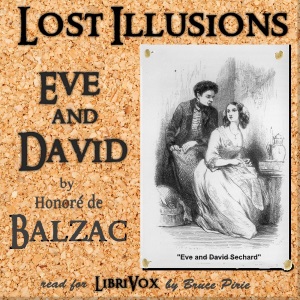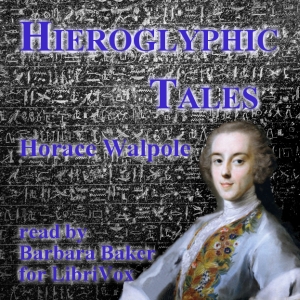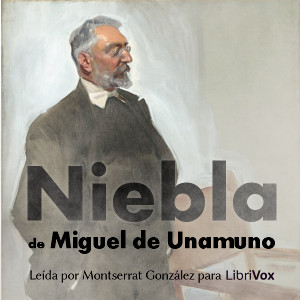James Parsons comes home to Little Primpton after serving in the Boer War. The whole town is proud of their new hero, who was awarded the Victoria Cross for risking his life to save a fellow soldier. However, for Jamie, nothing is the same anymore. His varied experience after leaving home has changed his worldview completely and he finds it impossible to go back to his former way of life and beliefs. Torn between individual freedom and obligations towards his family, Maugham portrays Jamie's struggles and social intolerance. - Summary by OCTL7
23 episodes
Hans of Iceland was written in 1821 and is the very first novel written by young Victor, years before he became the great Hugo. It has all the ingredients of a gothic novel: dreadful murders by the hand of a human monster, a young hero in love with the destitute heroine, royal court-intrigues and rebellious uprising, all set in dungeons, dark towers and the untamed nature of Norway.This audio-book has been recorded as Dramatic Reading with all the voices performed by one single reader, including laughs, sobs, groans, occasional screams and a lot of growls. I hope you will enjoy listening to this adventurous journey just as much as I enjoyed recording it. - Summary by Sonia
55 episodes
This extract, taken from Parodies of the works of English and American Authors, vol 1, of parodies of Tennyson's Charge of the Light Brigade covers such topics as the Clergy, the Fairer Sex, Doctors, Engineers and many others. - Summary by Kim
26 episodes
This is a collection of well-written engaging short stories written by "Q", the pen name of the prolific and eccentric Sir Arthur Thomas Quiller-Couch. - Summary by Amy Gramour
24 episodes
If a thing is not sensibly true it may be morally so. If it is not phenomenally true it may be so substantially. And it is possible that one may see substance in the idiom, so to speak, of the senses. That, I take it, is how the Greeks saw thunder-storms and other huge convulsions; that is how they saw meadow, grove and stream—in terms of their own fair humanity. They saw such natural phenomena as shadows of spiritual conflict or of spiritual calm, and within the appearance apprehended the truth. So it may be that I have done. Some such may be the explanation of all fairy experience. Let it be so. It is a fact, I believe, that there is nothing revealed in this book which will not bear a spiritual, and a moral, interpretation; and I venture to say of some of it that the moral implications involved are exceedingly momentous, and timely too. I need not refer to such matters any further. If they don't speak for themselves they will get no help from a preface. - Summary by Maurice Hewlett
16 episodes
Eric, artist for the king, has created a marvelous painting of a royal wedding. It is finished except for the face of the queen, which appeared to him in a dream. When he awoke, he had forgotten the form of the features. Obsessed with recapturing this vision, he goes on a quest to find the woman because he cannot paint another stroke until he sees those eyes again. During his journey, he discovers much more, perhaps even the true meaning of his dream and of his life. - Summary by Amy Gramour
30 episodes
Der Roman thematisiert den Entwicklungs- und Selbstfindungsprozess des jungen Törleß, der zur Zeit der k. und k. - Monarchie in einem Provinzinternat aufwächst und dort mit seinen Mitschülern einen anderen Jungen beim Stehlen erwischt. Die Geheimhaltung seiner Tat muss sich dieser Junge durch Abhängigkeit von Törleß und seinen Mitschülern erkaufen, die ihm in vielfacher Hinsicht stark zusetzen...der Roman ist eines der frühesten Werke, die an der Schwelle zur literarischen Moderne stehen. - Summary by Boris
10 episodes

Coningsby is the first of trilogy of political novels that Disraeli published in the 1840s, and gives an insight into his views of the political turmoil following the passage of the Great Reform Bill by the Whigs in 1832 (a second Reform Bill was passed in 1867 under Disraeli’s Tory leadership as prime minister). While Coningsby looks primarily at political questions, its successor -- Sybil, or the Two Nations -- was concerned with the “condition of England” question and the growing social and economic imbalance between rich and poor that in tje writer's view was hastened (though not begun) by the industrial revolution. Granted that Disraeli was not Dickens or Trollope or Eliot or one of the other giants of British letters in the nineteenth century, it’s a bit unfair to suggest (as some have) that the plots are thin and only there to provide the writer with a podium for setting forth his political and social views. It’s true that Boy Meets Girl, Boy Loses Girl, Boy Gets Girl, but much else happens as well, particularly thanks to the role played by the mysterious figure of the Jewish Sidonia, who in addition to enormous wealth and widespread international connections embodies a kind of wisdom that transcends the mere knowledge acquired by even the best educated Englishmen. Coningsby, himself a product of both Eton and Cambridge, is fortunate enough to be taken under his wing, and intelligent enough to accept his guidance. (Nicholas Clifford)
32 episodes
The author of Frankenstein returns with her take on an Austen novel. The mother is proud, the father has many vices, yet the aristocratic name must be kept. Even more so when lord Lodore dies. His wife and daughter find themselves without protection. This novel is conserned with gender equality, education and social justice. - Summary by Stav Nisser.
55 episodes

Ève and David (1843) is the final book in Balzac’s Lost Illusions trilogy, which is part of his sweeping set of novels collectively titled La Comédie Humaine. The story is set in post-Napoleonic France. In the first volume of the trilogy (Two Poets, 1837), we meet Lucien Chardon, an aspiring poet frustrated by the pettiness of provincial life. In the second volume (A Distinguished Provincial at Paris, 1839) Lucien, now using the more aristocratic-sounding surname "de Rubempré," leaves his family in order to seek fame and fortune in the literary world of Paris. By the end of that book, he faced imminent emotional and financial collapse.In this present volume, the reader is returned to the provincial town of Angoulême, where Lucien's sister Ève and her husband, Lucien's friend David, have been desperately struggling against clever competition to keep a their printing shop afloat. Their situation is complicated when Lucien's financial distress spills over into their lives.Balzac’s work was hugely influential in the development of realism in fiction. The Lost Illusions trilogy is one of his greatest achievements, and is named in the reference work 1001 Books You Must Read Before You Die. (Summary by Bruce Pirie)Other volumes in this series:Lost Illusions: Two PoetsLost Illusions: A Distinguished Provincial at Paris
The story of Lucien de Rubempré continues in the sequel, Scenes from a Courtesan's Life
20 episodes

This novel in verses is an example of Russian classic literature. The plot tells about young nobleman moving to country from St. Petersburg, driving there not only by mansion inheritance from his uncle but by the spleen, to find friendship and love which will turn out disappointing and even a tragedy. The main charm of the text is in its verses - the stanza consisted of 14 lines written in verses of iambic tetrameter has became classical since and has been called Onegin stanza.
Этот роман в стихах является образцом классической русской литературы. В основе сюжета история молодого дворянина, который переезжает в деревню из Санкт-Петербурга не только для того, чтобы вступить в наследование имением своего дяди, но и из-за сплина, тоски. Здесь он находит дружбу и любовь, которые в итоге оказываются разочарованием и оборачиваются трагедией. Основная же прелесть текста в стихе, которым он написан - эта строфа из 14 строк четырехстопного ямба с тех пор так и называется "онегинской".
(Summary by xenium5)
8 episodes

Don Quixote is a Spanish novel by Miguel de Cervantes Saavedra. Published in two volumes, in 1605 and 1615, Don Quixote is considered the most influential work of literature from the Spanish Golden Age and the entire Spanish literary canon. As a founding work of modern Western literature and one of the earliest canonical novels, it regularly appears high on lists of the greatest works of fiction ever published.... The story follows the adventures of a hidalgo named Mr. Alonso Quixano who reads so many chivalric romances that he loses his sanity and decides to set out to revive chivalry, undo wrongs, and bring justice to the world, under the name Don Quixote de la Mancha. He recruits a simple farmer, Sancho Panza, as his squire, who often employs a unique, earthy wit in dealing with Don Quixote's rhetorical orations on antiquated knighthood. Don Quixote, in the first part of the book, does not see the world for what it is and prefers to imagine that he is living out a knightly story. Throughout the novel, Cervantes uses such literary techniques as realism, metatheatre, and intertextuality. It had a major influence on the literary community, as evidenced by direct references in Alexandre Dumas' The Three Musketeers (1844), Mark Twain's Adventures of Huckleberry Finn (1884) and Edmond Rostand's Cyrano de Bergerac (1897), as well as the word "quixotic" and the epithet "Lothario." Arthur Schopenhauer cited Don Quixote as one of the four greatest novels ever written, along with Tristram Shandy, La Nouvelle Héloïse and Wilhelm Meister. ( Expatriate)
54 episodes
An early novel by W. Somerset Maugham about conflicting feelings of self-integrity, filial love, romantic love. Lucy Allerton and Alec MacKenzie have to choose between grasping happiness that is their due and upholding a set of moral values that define themselves. - Summary by Lilith Branda
21 episodes
Die Novelle "Bahnwärter Thiel" entstand 1887 und gehört zu den herausragenden Werken des Naturalismus. Thiel ist ein in sich gekehrter Mensch, der nicht viele Worte macht, sich jedoch mit den Nachbarskindern abgibt und seinen Beruf mit Hingebung ausführt. Er gerät in einen wachsenden inneren Konflikt, als seine Frau Minna stirbt und er sich wieder verheiratet um die Versorgung seines Sohnes Tobias abzusichern. Er versucht trotz wachsender Spannungen sein Leben in den gewohnten Bahnen zu halten, sieht sich jedoch mehr und mehr unfähig dazu. (Zusammenfassung von Eva K.)
3 episodes
One of James's last great stories, it is not actually a ghost story but has every claim to be considered such with its mysterious spectral essences surviving death and summoning the central character towards - well, what, exactly? That query is of the very essence of the story; and when the Beast finally does pounce out of the hidden Jungle in which it had hitherto so spectrally lurked, you (and he, the central male) might well find yourself startled by its name. - Summary by Tony Addison
6 episodes
Ubicada en la Europa del siglo XVIII y en plena efervescencia científica, el capitán de un barco ballenero escribe a su hermana Margaret su encuentro con el joven estudiante de filosofía natural Víctor Frankenstein. Dicho hombre ha descubierto el secreto para dar vida a la materia muerta y ha creado un ser vivo y, sin medir las consciencias de sus actos, ha empleado para ello partes de otros seres humanos muertos. El resultado es monstruoso y, a partir de aquí, se inicia una confrontación llevada hasta su extremo. Un constante cuestionamiento filosófico y moral del hombre contra su creador y viceversa que conduce la historia hasta su trágico final. Además de una obra maestra de la literatura, se trata de una fantástica novela que muestra los peligros de jugar a ser Dios con aquello que no se conoce y no se es capaz de puede controlar. - Summary by Phileas Fogg
28 episodes
A tale of the revenge of the earth, in this case, specifically, Mother Gunga, Goddess of the River Ganga, against the men who confine her power, The Bridge Builders is also a tale of the death of the Gods as their place in the earth is taken by the things of science. A close description of the building of a bridge across the River Ganges, the tale also tells of a vision of the Gods in an opium dream like a dream in the mind of Brahma; and when Brahma wakes, the Gods die. Or do they? ( Tony Addison)
4 episodes

Scenes from a Courtesan's Life is one of the last great works completed by Balzac for his huge novel series entitled The Human Comedy. Sections of this book, in various groupings and with various titles, were published between 1838 and 1847. It eventually settled into the four sections found in the present edition. The French title — Splendeurs et misères des courtesanes — literally, Splendors and Miseries of Courtesans — has also been translated as A Harlot High and Low. The story picks up at the end of Lost Illusions (1843), an earlier novel by Balzac. At the end of that book, Lucien de Rubempré (born Lucien Chardon), a young provincial poet with great ambitions but feeble moral will, was heading for Paris in the company of a mysterious Spanish priest. In the present book, we quickly discover that the "Spanish priest" is actually Jacques Collin, alias "Vautrin," a master criminal first introduced to readers in Balzac's Father Goriot (1835). Lucien develops a relationship with Esther van Gobseck, a prostitute (the "courtesan" of the title). With these three main figures — Lucien, Vautrin, and Esther — Balzac explores the corruption of the aristocracy, the world of prostitution, the courts, and the prisons of 19th-century Paris. With masterful depictions of society and individual psychology, Balzac is considered a father of realism in fiction. - Summary by Bruce Pirie
The Balzac Lost Illusions trilogy preceding this book:
Lost Illusions: Two Poets
Lost Illusions: A Distinguished Provincial at Paris
Lost Illusions: Ève and David
68 episodes
Surreal and satirical, these stories by the eighteenth century man of letters, Whig politician, art historian and antiquarian are '"...mere whimsical trifles, written chiefly for private entertainment, and for private amusement... an attempt to vary the stale and beaten class of stories and novels, which, though works of invention, are almost always devoid of imagination...." Horace Walpole - Summary by barbara2
8 episodes
Los miserables (título original en francés: Les misérables) es una novela del político, poeta y escritor francés Victor Hugo publicada en 1862, considerada como una de las obras más conocidas del siglo XIX. La novela, de estilo romántico, plantea a través de su argumento un razonamiento sobre el bien y el mal, sobre la ley, la política, la ética, la justicia y la religión. El autor confesó que se había inspirado en Vidocq, criminal francés que se redimió y acabó inaugurando la Policía Nacional francesa, para crear a los dos protagonistas y que la historia de su país le había inspirado para situar el contexto histórico: por ello, los personajes viven la Rebelión de junio (1832) y los posteriores cambios políticos. Además, el autor analiza los estereotipos de aquel momento y muestra su oposición a la pena de muerte. En su núcleo, al fin, la novela sirve como una defensa de los oprimidos sea cual sea el lugar o situación sociohistórica que vivan. - Summary by Wikipedia
71 episodes
A series of tales -- told by men, of course -- about women. Though the book first appeared in 1842, Balzac later added to it as an addenfum a tale of 1831, La Grande Bretèche. That will be read later, keeping it separate to mirror the form of the English translation here used. (More to follow) - Summary by Nicholas Clifford
3 episodes
La Grande Bretèche is an addendum to Balzac's Another Study of Woman, and is the final of a set of stories told around a dinner table. This one, given to the guests at about two in the morning, is tale of marital infidelity and revenge,and perhaps might have given some of the audience a sleepless night. ( Nicholas Clifford)
2 episodes

Jenny Winge is a Norwegian expatriate studying art in Rome, part of a Bohemian group of friends who explore the ancient City in an intoxicating passion for Beauty. Yearning for an immortal Love, she allows herself to fall into less-than-ideal romantic relationships and then has to struggle with all her might to recover her independence. Constantly resisting conformity, she demands absolute freedom for herself while always being tempted to fall back into the comfortable ruts of provincial domesticity. A profound psychological study of the social Outsider, the person who “sees through” the shallow façades of human social convention, this novel might also be seen as an early fictional exploration of the existentialist insistence on individual choice in all its terrifying responsibility. Nobel laureate Sigrid Undset, most famous for her later epic “Kristin Lavransdatter,” published this dark, remarkable, psychologically-dense novel in 1911, when the author was the same age as her protagonist and experiencing many of the same existential choices. ( Expatriate)
33 episodes
Possibly Wilkie Collins' most famous novel, The Woman In White remade the Gothic Horror novel by taking its characters and tropes and setting them in commonplace surroundings among "people like us", Featuring unforgettable characters such as the incomparable Count Fosco and the redoubtable Marion Halcombe (a woman for whom male Victorian readers politely inquired of Wilkie the address as they wanted to marry her), The Woman In White with its compassionate treatment of those suffering mental distress ought to be credited with having put the cause of mental health care a hundred years ahead - had not Jane Eyre with its madwoman in the attic been generally credited with the reverse. Read it for the female doubling central plot device alone - a rare feature in the writing of men about women. - Summary by Tony Addison
38 episodes
Niebla es una de las obras más conocidas de Unamuno. Esta “nivola”, como el propio autor la denominó quizás para diferenciarla del resto de sus obras, nos cuenta una historia a veces cómica y otras dramática, cargada de planteamientos filosóficos. A la vez narra el enamoramiento de Augusto, joven de vida acomodada que pone en cuestión todo lo que le ocurre, el ser o no ser, la capacidad de decidir del ser humano, incluso llega a enfrentarse y a cuestionar a su creador, Miguel de Unamuno. (Resumen de Montse González)
35 episodes
Iracema, a virgem tabajara consagrada a Tupã, apaixona-se por Martim, guerreiro branco, inimigo de seu povo. Por esse amor abandona a tribo, tornando-se sua esposa. Ao perceber, mais tarde, que Martim sente saudades de sua terra e talvez de alguma mulher, começa a sofrer. Tem o filho, Moacir, enquanto Martim está lutando em outras regiões. Quando ele volta, Iracema está prestes a morrer. (Rogerio M.)
9 episodes
Pawel Tschitschikow entwirft eine groteske Idee, die ihn zu Geld bringen soll. Er macht Geschäfte mit Leibeigenen, und zwar mit toten! Mittels Humor und beißender Satire stellt der große Erzähler Nikolai Gogol die marode, korrupte Gesellschaft seiner Zeit an den Pranger.
Das vorliegende Hörbuch enthält den ersten und zweiten Teil des Romans "Die toten Seelen". Der erste Band wurde 1842 veröffentlicht. Der zweite Teil erfuhr während seiner Entstehung ab 1840 mehrere Umarbeitungen. Vor seinem Tode im Jahr 1852 vernichtete Gogol die aktuellste Fassung, so dass hier nur Fragmente einer von 1842-1845 erschaffenen Neufassung, die Gogol ebenfalls in Teilen vernichtete, vorliegen. Lediglich der bemerkenswerte Schluss des Romans geht auf die Urfassung des zweiten Bandes zurück. (Zusammenfassung von Eva K.)
35 episodes
A collection of short stories on the South Sea Islands, among which are the famous "Red," "Rain," and "The Fall of Edward Barnard," the last of which contains the basic story of what came to be one of the most well-known among W. Somerset Maugham's novels, The Razor's Edge. - Summary by Lilith Branda
12 episodes
Perrault fue un autor francés que puso las bases por escrito de un nuevo género que haría historia, la de los "Cuentos de Hadas". Sus cuentos más famosos fueron incluídos en la publicación "Historias y Cuentos de Antaño" bajo el subtítulo de "Cuentos de Mamá Ganso" que son: "Caperucita Roja", "La Bella Durmiente del Bosque", "El Gato con Botas", "Cenicienta", "Barba Azul", "Pulgarcito", "Las Hadas" y "Riquete el del Copete",
En sus cuentos él se ayudaba con imágenes que tenía a su alrededor como bosques, castillos, princesas y marqueses, y también les agregaba cosas traídas del mundo de la fantasía. Hizo muchas adaptaciones de cuentos folklóricos ya existentes. - Summary by Phileas Fogg
12 episodes
In this work, first published in 1883, James once again writes of an American trying to settle in England. The woman at the center, however, is not a product of the Boston or New York upper classes, but of the American West, and is thus distinguished from the characters of many of his other transatlantic works. - Summary by Nicholas Clifford
10 episodes
Esta es la primera historia del legendario detective Sherlock Holmes y de su amigo, el doctor Watson, un cirujano militar que regresa a Londres luego de su participación en la guerra de Afganistán. Watson y Holmes se mudan al famoso 221B Baker Street, donde Watson se enfrenta a las excentricidades de Holmes y a su mágica habilidad para la deducción. En esta oportunidad Holmes es llamado para resolver un extraño asesinato: una casa desierta, un cadáver sin heridas, una misteriosa frase escrita con sangre en la pared, dos oficiales de Scotland Yard que no tienen pistas... - Summary by Phileas Fogg
15 episodes
Julien Sorel, ambitieux fils de scieur, fait son entrée dans le monde de la bourgeoisie comme précepteur. Où son ambition le mènera-t-il et à quelles obstacles fera-t-elle face ? À vous de le découvrir.
Résumé par Ezwa.
75 episodes

Don Quixote is a Spanish novel by Miguel de Cervantes Saavedra. Published in two volumes, in 1605 and 1615, Don Quixote is considered the most influential work of literature from the Spanish Golden Age and the entire Spanish literary canon. As a founding work of modern Western literature and one of the earliest canonical novels, it regularly appears high on lists of the greatest works of fiction ever published.... The story follows the adventures of a hidalgo named Mr. Alonso Quixano who reads so many chivalric romances that he loses his sanity and decides to set out to revive chivalry, undo wrongs, and bring justice to the world, under the name Don Quixote de la Mancha. He recruits a simple farmer, Sancho Panza, as his squire, who often employs a unique, earthy wit in dealing with Don Quixote's rhetorical orations on antiquated knighthood. Don Quixote, in the first part of the book, does not see the world for what it is and prefers to imagine that he is living out a knightly story. Throughout the novel, Cervantes uses such literary techniques as realism, metatheatre, and intertextuality. It had a major influence on the literary community, as evidenced by direct references in Alexandre Dumas' The Three Musketeers (1844), Mark Twain's Adventures of Huckleberry Finn (1884) and Edmond Rostand's Cyrano de Bergerac (1897), as well as the word "quixotic" and the epithet "Lothario." Arthur Schopenhauer cited Don Quixote as one of the four greatest novels ever written, along with Tristram Shandy, La Nouvelle Héloïse and Wilhelm Meister. - Summary by Wikipedia
75 episodes
Liza of Lambeth focuses on the challenges of life facing Liza, an 18 year old factory girl who lives in the poverty of the slums of 1890s London. The main plot is driven by Liza's affections and the consequences these have for her. Based on W Somerset Maugham's experiences as a visiting trainee Doctor at the time, the book is an insight into working class life at the time and was his debut, the success of which led to him pursuing his vocation not as a Doctor, but instead a novelist. - Summary by Hatton43
12 episodes
Bernard Langdon is close to earning his degree in medicine when his family finds itself in financial difficulties, forcing Langdon to interrupt his studies for a time in order to earn money with which to fund the rest of his degree. He therefore leaves Boston in order to teach at a school in a village in the area. One of his students is Elsie Venner, a seventeen year-old girl, who is avoided by her peers and keeps apart. Somehow, Elsie exerts a great fascination on Langdon, as there is something distinctly different about her with her strangeness and quick temper. Elsie Venner is one of Oliver Wendell Holmes' "medicated novels", in which he explores a medical condition of a character. Holmes was teaching at Harvard Medical School when this book was published, and he chose to let a professor of medicine narrate the story. Elsie Venner is notable for its strong Boston local colour, being at the same time the book in which Holmes coined the term "Boston Brahmin". - Summary by Carolin
37 episodes
Einer älteren Frau, Mutter und Großmutter, eröffnen sich nach dem Tode ihres Mannes Einsichten in neue Lebensperspektiven. Gleichzeitig stößt sie an die Grenzen des Frauenbildes ihrer Gesellschaft. Die 1894 veröffentlichte Novelle macht uns mit der Hauptperson zunächst in einer Irrenanstalt bekannt. Die Erzählung aus der Perspektive ihres Arztes dient als Rahmenhandlung, ihre Tagebuchaufzeichnungen stellen die Binnenhandlung dar. Hedwig Dohm setzte sich in ihren Publikationen für die Gleichstellung der Frauen ein. (Zusammenfassung von Eva K.)
8 episodes

Our central character is Isabel Archer of Albany, New York, a young woman of no great means, and no great beauty (that is, by her own estimation; others disagree) yet of rich imagination, high ideals and a thirst for knowledge of the world. Carried off by her aunt to England, she quite unexpectedly finds herself the beneficiary of a substantial legacy from her uncle, a very successful American banker in London. It will, her admiring cousin says to his father, allow her “to put a little wind in her sails” and to see the world.
Though some American reviewers rather dismissed the book when it appeared in the mid-1880s, for other readers today The Portrait of a Lady has become THE Great American Novel, or at least very close to the top. That is for a number of reasons, including among others the delineations of character and the psychological depths of the work. A few years ago, in a biographical study of James, Michael Gorra drew on it as a central work (not surprisingly his book is called Portrait of a Novel: Henry James and the Making of an American Masterpiece). James himself tinkered with it over the years, and the text here comes from the so-called New York edition of 1907-09.
Much of the action takes place in Italy, particularly n the expatriate communities of Florence and Rome. Without giving anything away, it’s worth noting that James’s ending for the novel has caused some puzzlement, not to say controversy, among readers. (Nicholas Clifford)
38 episodes
Within these pages find passages from the "lost diaries" of a wide range of people: royal, regular, famous, infamous, historical, and fictional. - Summary by A. Gramour
20 episodes

Recopilación de una docena de relatos de misterio y una teoría del cosmos que constituyen un pilar fundamental para el desarrollo de la literatura fantástica y la ciencia ficción en la Argentina. Leopoldo Lugones (1874-1938) fue una figura central en la literatura argentina y universalmente reconocido; fue conductor de pensamiento y estilos. No deja de generar constantes polémicas; no tanto por su obra literaria indiscutible, sino por su protagonismo político, que sufrió fuertes virajes ideológicos a lo largo de su vida, pasando por el socialismo, el liberalismo, el conservadurismo y el fascismo. Su trabajo incesante se plasmó en numerosos escritos, artículos de prensa y conferencias que le merecieron el nombramiento en la Asamblea de Cooperación Intelectual de la Liga de las Naciones (1924), el Premio Nacional de Literatura (1926) y la presidencia de la Sociedad Argentina de Escritores, fundada con su impulso (1928). Director de la Biblioteca Nacional de Maestros; era éste su cargo cuando las circunstancias políticas de la década de 1930 (la primera "Década Infame") lo llevaron a suicidarse. Esto aconteció el 18 de febrero de 1938 en un hotel del Tigre (llamado "El tropezón") al ingerir una mezcla de cianuro y whisky. - Summary by Phileas Fogg
24 episodes

Armand Durand, published in 1868, was written by Rosanna Leprohon, an English-speaker with an insider’s knowledge of French Canada, thanks to her Montreal education and marriage to a man from an old Québécois family.
Paul Durand, a prosperous Québécois farmer, marries in quick succession two very different wives, and fathers two very different sons. The first son, Armand, delicate and bookish, is destined for a legal career in the city; the second, Paul Junior, tougher and down-to-earth, continues life on the farm. The story deals with troubling aspects of parental, sibling, and marital relationships.
Armand Durand may be one of the best Canadian novels that no one has heard of. It was well received in both its English and French editions, but is today hard to find, especially in the original English. Silenced Sextet (1993), a study of 19th-century Canadian women authors whose works were initially popular but later slipped into obscurity, offers this assessment: “it is a mature novel, valuable for its complex human relationships and also for its glimpses of Montreal life in Leprohon’s own time and of rural Quebec life in somewhat earlier days.” - Summary by Bruce Pirie
19 episodes

"Please sir, I want some more," the famous line spoken by Oliver Twist at age nine, becomes the tipping point of a huge change in Oliver's life. He is soon captured into the service of Fagin and his gang of pick-pocketing boys. But, Mr. Brownlow saves him from arrest, and for the first time in his young life Oliver finds comfort and caring. Unfortunately, he is recaptured into the seedy and disgusting world he had escaped, and meets with Bill Sykes, a dangerous criminal. There are numerous delightful or wicked characters that carry the story along, such as the Artful Dodger-- a boy of the streets under Fagin, Mr. Bumble the Beadle, looking for ways to get rid of Oliver, Nancy who makes a fateful betrayal, and the Maylies, whose affection Oliver craves. The author's descriptions of the back street life in London, bring us full force into the crushing poverty and the terrible way in which poor people were treated during that time. Charles Dickens wrote Oliver Twist as a serial in 1837, and it is considered one of the most popular in English literature. - Summary by Mil Nicholson
53 episodes
An extraordinary work of the aesthetic imagination, cast in the form of a psycho-drama detailing the events of one night in the life of the aged hermit, later Saint, Anthony, in the course of which his claims to sainthood are severely tested by, among other things, Gods, Magicians, Science, Food, Monstres, Lust and Death. Beautifully translated by Lafcadio Hearn, justly celebrated for his eerie re-tellings of Japanese ghost stories and legends, it boasts equally extraordinary printworks (for those who follow the link to the Online Text) by renowned symbolist artist Odilon Redon. - Summary by Tony Addison
14 episodes

This story, about a man who wakes up transformed into a bug and the repercussions it has on his life and the people around him, has intrigued me for many years. The translation is by Ian Johnston, not the translator that is in Gutenberg; I like Johnston's more.
What does it mean? [Spoiler possibly]In my mind it is not complicated at all and is most probably an autobiography of how Kafka himself had experienced his early life living with his parents. Kafka describes how he had experienced his parents’ financial and emotional exploitation's of him, to the point of detaching from them and thereby ceasing to be their son (the real metamorphosis). Gregor’s metamorphosis is that of Kafka’s being an obedient son, subserviently paying for his parents’ narcissistic needs with his own life, into being a disobedient one—as if he had become a ‘piece of vermin’. Gregor’s parents possessed a large sum of money in savings, which symbolizes the needlessness of Gregor’s exploitation. In other words, the parents did not love him for who he was, but for his loyal willingness to undergo this exploitation.
Reduced to vermin, Gregor can (or will) no longer financially benefit his parents. It is the parents that caused Gregor’s/Kafka’s metamorphosis. The debt Gregor intended to repay his parents symbolizes the emotional debt many adult children continue to feel towards their elderly parents for the love and care they have provided. Sister Grete, at first siding with her brother against their unfriendliest father, eventually switches sides after her brother’s metamorphosis, conveniently seizing first place in the sibling hierarchy, a reference to Kafka’s relationship with one of his siblings.
The reason why the book continues to enjoy popularity among large audiences of readers, in my opinion, is because they recognize themselves in Gregor Samsa, which makes it all the more astounding how many ‘expert’ interpretations attempt to distract students of Kafka away from the most likely one. I know that some of our absolute best LibriVox readers have already recorded this marvelous story but this but it has also been on my list of "yearn to record" things for a long time and for my personal and entirely selfish pleasure now is the time to do it before I get any older or another flood hits us.
3 episodes
A moving adventure story narrated by Thomas Wingfield, an Englishman, for Queen Elizabeth 1 of England about the murder of his mother, his trail of vengeance against the murderer which leads him to the Spanish Inquisition, slavery, romance and living under Montezuma in his kingdom which is now called Mexico. Summary by Patrick79
41 episodes
Es ésta una obra semiautobiográfica de Johann Wolfgang von Goethe, la cual ha recibido diferentes nombres: Las penas del joven...Los sufrimientos del joven...o simplemente “El joven Werther”. Werther, joven artista de gran sensibilidad, conoce a una mujer, Lotte, ya comprometida con Albert, de la cual se enamora perdidamente. Aquel va contando a su amigo de forma epistolar todos sus sentimientos.Goethe, consiguió con esta obra pasar de ser un autor desconocido a un autor célebre, autor de masas. Fue considerada uno de los trabajos más importantes en la Europa de la época. - Summary by Montse González.
14 episodes
El equipaje del rey José (1875) es la primera novela de la segunda serie de los Episodios nacionales de Benito Pérez Galdós. En él, el escritor presenta a los personajes centrales de esta serie: Salvador Monsalud, Carlos Garrote, Jenara Barahona y Juan de Pipaón; a través de ellos se describe la raíz del enfrentamiento entre liberales y absolutistas -representado por la lucha personal entre Salvador Monsalud y Carlos Garrote- que se había ido incubando durante la Guerra de Independencia y que a partir de entonces marcará la historia de España. (Summary by KendalRigans)
28 episodes

Karl Duschek steht im Schatten seines dominanten, strengen, unerbittlichen Vaters, der ein äußerst erfolgreicher Offizier der KuK-Monarchie kurz vor Beginn des ersten Weltkrieges ist und eine glänzende Karriere macht. Durch den Druck des Vaters schlägt auch Karl die militärische Laufbahn ein, obwohl er eigentlich eher schüchtern und zurückhaltend ist und sich für Musik interessiert. Er ist innerlich zerrissen: da ist einerseits die Angst vor seinem ehrgeizigen Vater, dessen Strenge so selten väterliche Liebe aufblitzen lässt, und dessen Ehrgeiz er versucht, gerecht zu werden, und andererseits der Wunsch, sich von seinem Vater, der feinen Gesellschaft und der ganzen soldatischen Welt abzuwenden und zu emanzipieren. Schließlich kommt er in Kontakt mit einem aufrüherischen, geheimen Zirkel. Den Verschwörern gehört auch die mysteriöse Sinaïda an, in die sich Karl verliebt. Schließlich kommt die große Gelegenheit: der Besuch des russischen Zaren wird angekündigt, und Karl wird ausersehen, einen tödlichen Anschlag auf ihn zu verüben... - Summary by Boris
10 episodes
A frank look at the revolt of the younger generation following World War I, the book follows the Trelawney family. The father looks eagerly forward to his return home after serving an important but harrowing stint in the army. What he finds at home is not what he expects, as his two daughters test the boundaries of new morals, ethics, and dress. Many of the generational and class issues central to the theme continue to resonate in families and society. The book was made into a silent movie starring Gloria Swanson in 1923. Summary by Kate Follis
33 episodes

Главным героем романа является Фёдор Иванович Лаврецкий, дворянин, имеющий многие черты самого Тургенева, например в том, что воспитан он был суровой помещицей. Роман был впервые опубликован в 1859 году и послужил поводом серьёзной размолвки между Тургеневым и Гончаровым, который обвинил Тургенева в плагиате, после того как Гончаров в кругу знакомых поделился идеей нового романа (им стал "Обрыв"). Схожести между произведениями прослеживаются, но различий, конечно, гораздо больше.
The protagonist of this novel, Theodor Ivanovich Lavretsky, a nobleman, shares many characteristics with Turgenev himself, for instance in that he was brought up by a strict woman landowner. The novel was first published in 1859 and became the cause of a serious falling out between Turgenev and Goncharov, the latter accusing Turgenev of plagiarizing the idea, after Goncharov's sharing his thoughts on his new book among acquaintances (the book was "The Precipice"). One can trace similarities between the novels, yet there are many more difference, of course. (Summary by tovarisch)
25 episodes
Demônios é um conto de terror, com temática sobrenatural. Em um dia que parece não ter início nem fim, um escritor desperta e observa que não houve amanhecer. As horas passam e o dia não surge. Não bastasse a treva que domina o ambiente, o escritor descobre que aqueles que o cercavam jaziam mortos. Em meio ao pânico e ao desespero, sai em busca de sua amada, Laura, na esperança de encontrá-la, enfrentando o desconhecido e o pavor daquela noite interminável. - Summary by Rogerio Maciel
4 episodes

















































